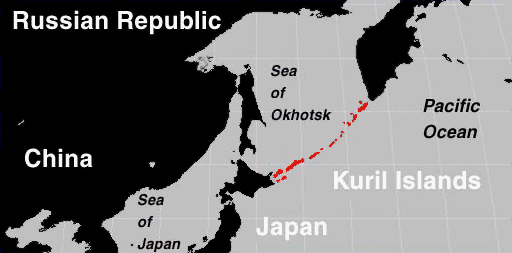 The islands of
the Kuril Archipelago form the eastern boundary of the Okhotsk Sea and a
bridge between Hokkaido, the northernmost island of Japan, and the Russian
peninsula of Kamchatka. They are a natural laboratory for investigations
into the origin, subsequent evolution, and long-term maintenance of insular
populations. Although considerable information is available for wide-ranging,
commercially important species, such as salmon and marine mammals, the flora
and fauna of the Kurils as a whole are poorly known. At the same time, the
current political situation poses a serious environmental threat to the
islands. The islands of
the Kuril Archipelago form the eastern boundary of the Okhotsk Sea and a
bridge between Hokkaido, the northernmost island of Japan, and the Russian
peninsula of Kamchatka. They are a natural laboratory for investigations
into the origin, subsequent evolution, and long-term maintenance of insular
populations. Although considerable information is available for wide-ranging,
commercially important species, such as salmon and marine mammals, the flora
and fauna of the Kurils as a whole are poorly known. At the same time, the
current political situation poses a serious environmental threat to the
islands.
 In this request, it is
proposed that a team of American, Russian, and Japanese scientists conduct a
survey and inventory of the plants, insects, spiders, freshwater and
terrestrial mollusks, freshwater fishes, and terrestrial vertebrates of the
Kuril Islands. With financial support already committed to the project by the
Russian Academy of Sciences and the Japan Society for the Promotion of Science,
the cost of the work will be shared by all three nations. With experience
gained in 1994 collecting on the four primary islands of the "disputed"
southern Kurils (whose rightful ownership is the focus of long-standing debate
between Russia and Japan), it is now proposed that the work be extended over
the next five years to include all major islands of the Archipelago. In this request, it is
proposed that a team of American, Russian, and Japanese scientists conduct a
survey and inventory of the plants, insects, spiders, freshwater and
terrestrial mollusks, freshwater fishes, and terrestrial vertebrates of the
Kuril Islands. With financial support already committed to the project by the
Russian Academy of Sciences and the Japan Society for the Promotion of Science,
the cost of the work will be shared by all three nations. With experience
gained in 1994 collecting on the four primary islands of the "disputed"
southern Kurils (whose rightful ownership is the focus of long-standing debate
between Russia and Japan), it is now proposed that the work be extended over
the next five years to include all major islands of the Archipelago.
 Using standardized
survey methods, modern computer-based inventory procedures, and dissemination
of information through the Internet, the results of the survey will provide
important baseline data on patterns of species diversity that can be compared
accurately with other regions sampled in similar ways. Working cooperatively
with universities and the national and local governments of the host country,
the project will provide training for faculty, students, and government
biologists. Finally, the work will provide a foundation of information that
will promote long-term future research as well as conservation of these unique
island biotas. Using standardized
survey methods, modern computer-based inventory procedures, and dissemination
of information through the Internet, the results of the survey will provide
important baseline data on patterns of species diversity that can be compared
accurately with other regions sampled in similar ways. Working cooperatively
with universities and the national and local governments of the host country,
the project will provide training for faculty, students, and government
biologists. Finally, the work will provide a foundation of information that
will promote long-term future research as well as conservation of these unique
island biotas.
|

![]()
![]()

 The islands of
the Kuril Archipelago form the eastern boundary of the Okhotsk Sea and a
bridge between Hokkaido, the northernmost island of Japan, and the Russian
peninsula of Kamchatka. They are a natural laboratory for investigations
into the origin, subsequent evolution, and long-term maintenance of insular
populations. Although considerable information is available for wide-ranging,
commercially important species, such as salmon and marine mammals, the flora
and fauna of the Kurils as a whole are poorly known. At the same time, the
current political situation poses a serious environmental threat to the
islands.
The islands of
the Kuril Archipelago form the eastern boundary of the Okhotsk Sea and a
bridge between Hokkaido, the northernmost island of Japan, and the Russian
peninsula of Kamchatka. They are a natural laboratory for investigations
into the origin, subsequent evolution, and long-term maintenance of insular
populations. Although considerable information is available for wide-ranging,
commercially important species, such as salmon and marine mammals, the flora
and fauna of the Kurils as a whole are poorly known. At the same time, the
current political situation poses a serious environmental threat to the
islands.
![]()